HAPPY OZONE DAY!
In 1990, air pollution reached very high levels in Athens and in many major cities of Greece.
The pollution was characterized by:
a. High concentrations of particles.
b. Photochemical smog, linked to an excess of Nitrogen oxides, Sulphur oxides, Carbon monoxide, Ozone, Hydrocarbons.
The awareness of people for the consequences to their health by this phenomenon led to a series of measures.
Such measures were:
- Rotational traffic regulation system. Cars with odd numbers can circulate in the centre of Athens on odd days of the month, whereas cars with even numbers can circulate on even days. This system still applies in Athens.
- Imposition of measures on industries to reduce air pollutants
- Mandatory inspections of all private vehicles once per year and public vehicles twice a year.
- Incentive to change the old cars, which led to the replacement more than 260.000 cars national wide, of which 160.000 were in Athens.
- Expansion of Athens's subway by more than 25Km, which significantly reduced the daily trips by private cars and taxis.
- Dedicated lanes for buses in most main streets to improve bus speed. This system increased the average bus speed from 16Km/h to 30Km/h.
The above actions result to the following measurements as provided by the European Environmental Agency (Air Pollution Fact Sheet 2014) for the air pollution emissions since 1990 and the projections up to 2020.
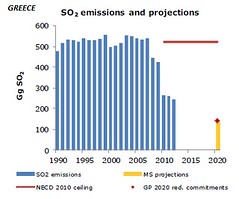
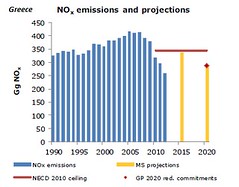
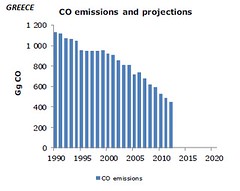
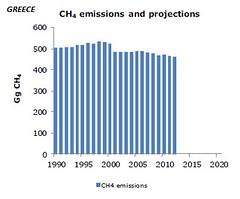
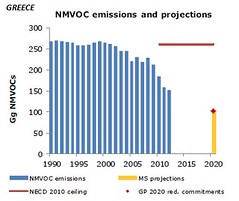
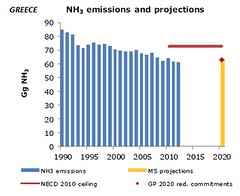
The main reasons for the serious decline of the air pollutants are the measures described above, as well as the increase of Renewable Energy Sources and Natural Gas, replacing Oil in energy production.
NMVOC stands for Non methane volatile organic compounds. NMVOCs include a variety of chemicals such as benzene (C6H6) and 1,3-butadiene, are directly hazardous to human health. NMVOCs are also precursors of ground-level ozone.
These seem to be the good news. The bad news is that last winter we had a new polluting factor. The concentration of very small particles (PM 2.5) in Athens was measured to have a registered high of 300 mg/m3 when the target value recommended by the EU is 25mg/m3!
As experts say, 80 percent of this pollution was being caused by wood fires.
The reason for the steep rise in heating oil consumption tax (due to crisis), which led many Athenians and Greeks to using more polluting fireplaces for heating this winter, instead of the traditional systems based on, more expensive, oil or natural gas.
Another bad news is the difficulty of reducing the ground ozone as air pollutant, mainly in Athens.
A few days ago, at September the 3rd, the Ozone concentration was measured at 250μg/m3, when the EU limit is 120μg/m3.
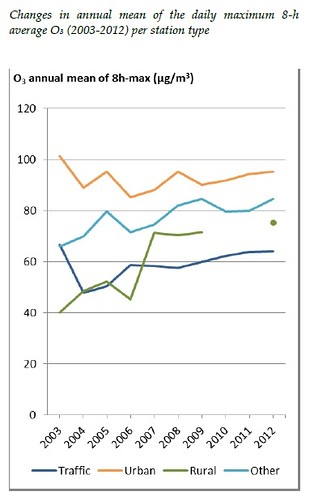
One of the most interesting measures applied is the “transparency” in air pollution levels.
The Ministry of Environment and Climate change (Yes we do had such a ministry!!) which changed its name this year to “Ministry of Reconstruction of Production, Environment & Energy” (due to the economic crisis), has installed sensors which measure the concentration of pollutants in the atmosphere in the Province of Athens.
I do believe that systematic informing of citizens about air pollution levels and their consequences on health are an important pressure to all factors that are responsible for the implementation of pollution measures.
You can see these measurements in English at:
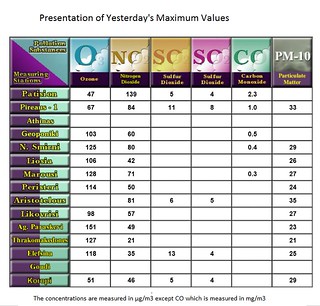
Everybody knows that breathing clear air is both healthy and enjoyable.
Of course we cannot ask from the industries and the transport vehicles to produce oxygen :)
But, every citizen, company, organization and state has the responsibility to make its maximum efforts to protect the human beings and all the living creatures from the pollution of air, water and land around us.
The effort for this never ends.
7 Comments
Thanks for the report and all graphs regarding the issue mate. =) Keep sharing!
Posted 20-09-2015 10:19
It feels wonderful to see the tremendous efforts of Greece to address the air pollution be it an incentive to change old cars or expanded subway. But yeah miles to go yet to reduce the PM of 2.5. I am hopeful that the efforts are being made to control forest fires and public is made aware about the issue.
Thank you for the detailed report with facts and figures :)
Posted 19-09-2015 12:24
It is rather ok to have PM 2.5 rather than PM 10. Most countries are still dealing with Particulate Matter 10 and that's more harmful since it can easily be inhaled. With PM 10, I am pretty sure Greece will fix that soon. Great job, Ambassador.
Posted 18-09-2015 07:24
It seems to me that Greece is really doing a lot. Other countries should learn from them.
Posted 18-09-2015 07:23
Lets hope the required actions will be there to control the air pollution. Thanks for sharing (Y)
Posted 17-09-2015 21:10
Glad to know that so many measures and efforts are put in to stop the pollution.Yes I agree that all of us have a role to play in the reduction of pollution of air,land and water.Thanks for sharing.
Posted 17-09-2015 19:56
On International Ozone..Day , it is good to read that in Greece there are so many measures in place to control air pollution. All these are showing positive results in the form of negative/declining trend of pollutants in the graphs you shared. But the increasing concentration of PM2.5 due to wood fires is a cause of worry , hope authorities are looking into it and would take serious measures to improve this.
Thanks for an informative report , Konstantinos.
Posted 17-09-2015 03:42